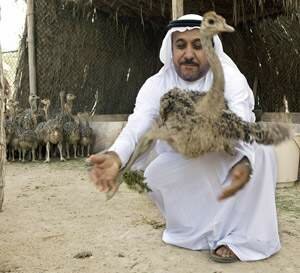 It’s big, it’s fast … and it’s back
It’s big, it’s fast … and it’s back
(The National) RAS AL KHAIMAH UAEÂ — For thousands of years, ostriches roamed the Arabian Peninsula.
They came to represent wealth and elegance, prized for their meat, eggs, feathers and leather. In ancient times they were used as a sacrificial animal, their image painted on pottery and their eggs traded as far away as China.
But their very value was their undoing, and they were hunted to extinction. By the 1960s, the Arabian ostrich was no more.
Now, Mohammed al Mehrezi is slowly bringing its cousin, the Somali ostrich, back to the Middle East.
It began 17 years ago. On a dusty road in Somalia, Mohammed stood motionless, mesmerized by the strange creatures before him.
“I was standing by the road with two large birds,†he recalls. “I said, they are not hens, they are not ducks, they are not swans. They are something strange.â€
The next day, Mohammed took leave from his UN peacekeeping mission and was on a plane back home to Abu Dhabi. In his carry-on baggage: two baby ostriches in a cardboard box.
“I bought this first bird for US$10,†he says. “The ostrich farm started as a hobby converted into business.â€
Nearly two decades have passed since that fateful day and Mohammed is now the proud owner of 150 adult ostriches and 70 chicks that he keeps at his Digdaga ostrich farm.
In the beginning, his new ostriches brought a mixed reaction from his friends. “They were surprised of this bird,†he says. And little wonder. The ostrich is a bird of prehistoric proportions. Ostriches can grow to 150kg, sprint at more than 70km an hour and leap more than five metres in a single stride. Its eyeballs are nearly 5cm across and its taloned toes bear a great resemblance to a camel’s foot. “The people here, they said, ‘Either this is a very well grown hen or a poorly cared for camel’. They don’t know what is this bird. They were happy to see this bird and my children also love them.†Mohammed left his first two chicks under the care of his wife and children at a farm in Abu Dhabi. When he returned on his next trip, he brought six more with him. “When [we] brought them home they started growing. We had a lot of difficulty to grow them,†he says, “but then I liked the animal. Because this bird is sort of human. He loves and hates and gets jealous. He has feeling. And he is a shy bird. “So I thought to expand this project. Due to my knowledge that the ostrich was once an Arabian bird, it lived in the Arabian Peninsula, I became convinced that it could live in this climate.†Mohammed purchased more birds from Nairobi, bringing his flock to a total of 20. Within a few months, Mohammed’s new pets had laid 200 eggs. “Then I was forced to buy incubators and hatchers. I brought the first from Belgium, because it is also famous for ostrich hatching. Out of 200 I got 80 successful eggs.†“They multiply,†he says. In mating season, which lasts from the middle of February until the end of April in the UAE, visitors to the farm can watch the ostriches perform an elaborate dance of flapping and squatting. The birds lay between 20 and 40 eggs, which spend 42 days in the incubator and three days in the hatcher to soften the shell. On Mohammed’s farm, each male has one or two mates. “He will restrict his love to these two and he will fight and become very jealous if any other males come near. They are sentimental animals.†But when it comes to business, Mohammed puts his emotions aside. Each bird consumes five kilograms of alfalfa and pellets a day at a cost of Dh12,000 a month for the flock. And so, the birds must earn their keep. For Mohammed’s ostriches, it is a case of eat and be eaten. “The ostrich as an animal is a meat producer,†says Mohammed. “The meat is very high in protein and very, very low in cholesterol. So it’s a good source of meat.†The ostriches are slaughtered at eight to 12 months. Meat costs Dh75 a kilogram and can be bought in supermarkets or eaten in restaurants in Abu Dhabi, Dubai and elsewhere. Sometimes, people buy ostriches to slaughter themselves. “A pair of ostriches, male and female, costs Dh700,†he says, adding that some people prefer to keep the birds as pets. “The skin can be sold, the feathers can be sold, the fingers can be sold and used like ivory as decoration. The leather can be used for handbags and shoes. The eggs can be used … as decoration. The bone can be used for artificial teeth. So it is a fully used animal.†The bird produces three types of feathers. Two kilograms of fine feathers can fetch as much as Dh200 in Europe, says Mohammed. In 2005, Mohammed’s curiosity took him to an ostrich egg carving centre in Jordan. There, he met a local artisan who offered to carve and paint eggs for Mohammed. “We do date trees, pictures of the sheikhs, al maha animal [the Arabian oryx], sometimes we do the ostrich itself.†The decorated eggs sell for US$100 (Dh367) at souvenir shops and hotel boutiques. As a mark of success, he boasts that his ostrich eggs are sold at the Burj al Arab hotel. The artist produces about 1,000 per year. For the brave, eggs can be cooked. “Like an omelette,†suggests Mohammed. “One egg is equivalent to 24 chicken eggs. It’s all white, like custard after cooking.†And, he adds, it tastes like blue cheese. Mohammed does not name the birds but he remembers his first two ostriches with love. “They were very friendly. They ate my ghutra, they ate my fingers. They try and play with me but most of my ostriches are friendly.†Mohammed’s current farm is a desert lot shaded by ghaf trees that was originally donated by Sheikh Saqr Al Qassimi, the Ruler of Ras al Khaimah, in 2002. His old ostrich farm is now a date orchard. Although Mohammed’s farm is renowned, his story has remained largely unknown. “Most people don’t know who is the owner,†he says. “When Sheikh Saqr gave me the land it was to have a bird zoo. It is famous and I want to make it as a retreat. “I’m planning to have some other birds. Just yesterday I bought two emu and I’m going to buy a white ostrich.†For Mohammed’s flightless birds, the sky’s the limit. [email protected]






